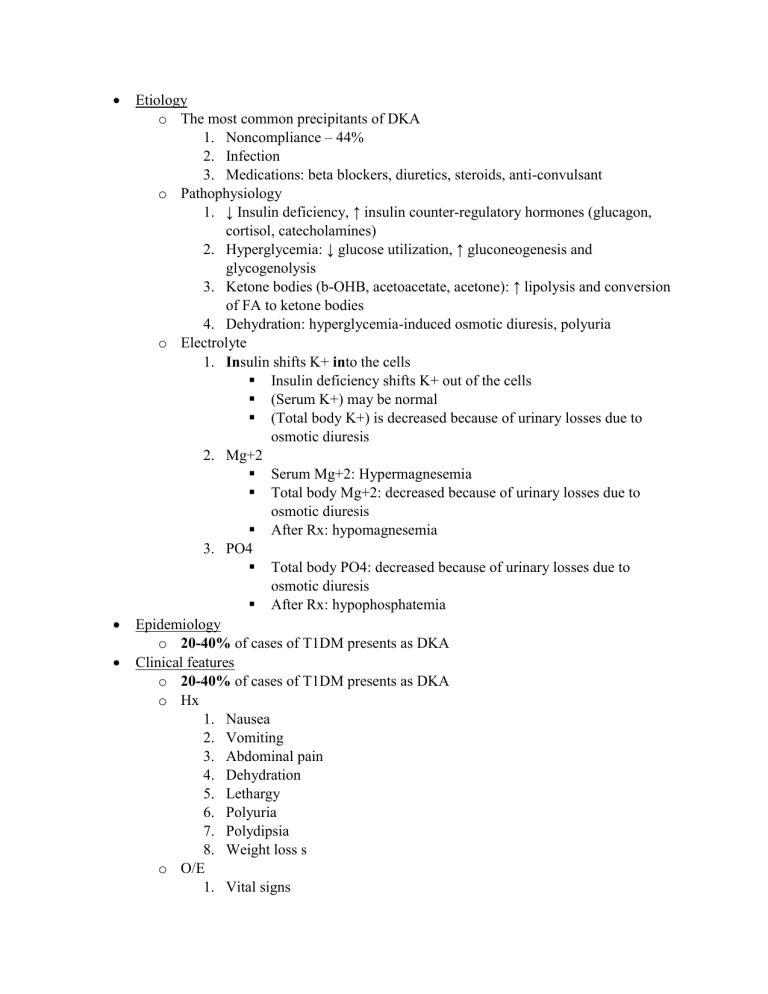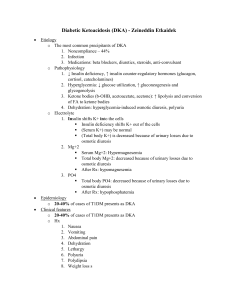
Etiology o The most common precipitants of DKA 1. Noncompliance – 44% 2. Infection 3. Medications: beta blockers, diuretics, steroids, anti-convulsant o Pathophysiology 1. ↓ Insulin deficiency, ↑ insulin counter-regulatory hormones (glucagon, cortisol, catecholamines) 2. Hyperglycemia: ↓ glucose utilization, ↑ gluconeogenesis and glycogenolysis 3. Ketone bodies (b-OHB, acetoacetate, acetone): ↑ lipolysis and conversion of FA to ketone bodies 4. Dehydration: hyperglycemia-induced osmotic diuresis, polyuria o Electrolyte 1. Insulin shifts K+ into the cells Insulin deficiency shifts K+ out of the cells (Serum K+) may be normal (Total body K+) is decreased because of urinary losses due to osmotic diuresis 2. Mg+2 Serum Mg+2: Hypermagnesemia Total body Mg+2: decreased because of urinary losses due to osmotic diuresis After Rx: hypomagnesemia 3. PO4 Total body PO4: decreased because of urinary losses due to osmotic diuresis After Rx: hypophosphatemia Epidemiology o 20-40% of cases of T1DM presents as DKA Clinical features o 20-40% of cases of T1DM presents as DKA o Hx 1. Nausea 2. Vomiting 3. Abdominal pain 4. Dehydration 5. Lethargy 6. Polyuria 7. Polydipsia 8. Weight loss s o O/E 1. Vital signs 2. Mental status (alert, drowsy, stupor/coma) 3. Kussmaul respiration: hyperventilation with deep, sighing respiration 4. Fruity odor of the breath: due to acetone Investigations o Dextro test (glucometer) o UA 1. Glycosuria 2. Ketonuria o ABGs 1. Metabolic acidosis o CBC o HbA1c Criteria and classification Plasma glucose (mg/dL) Urine ketone pH Serum HCO3 Clinically Mild >250 + 7.25-7.30 15-18 Alert Moderate Severe 7.00-7.25 10-15 Drowsy <7 <10 Stupor Management o ICU o Insulin 1. MOA ↑ movement of glucose into cells ↓ hepatic glucose production ↓ movement of FA to the liver 2. Don’t give insulin bolus Does not speed the recovery Increases the risk of hypokalemia and hypoglycemia 3. Start regular/plain insulin infusion at a rate of 0.1unit/kg/hr o Rehydration 1. MOA Improves renal perfusion and enhances renal excretion of glu 2. Initial IV bolus 10-20mL/kg 0.9NS over 1-2hrs 0.9 NS (isotonic) because the pt is hypertonic to keep Fluid in the intravascular space 3. IVF rate = (85cc/kg + maintenance – bolus) / 23hr o o o o 85cc/kg comes from 8.5 % dehydration Bolus: 0.9 NS (isotonic) Maintenance: ½ NS (hypotonic) 4. D5: RBS <300mg/dL 5. D10: RBS <200mg/dL Corrected Na = Na + 1.6 mEq/L for every 100mg/dL glucose above 100 E osm = 2 x Na(uncorrected) x Glu 1. Na and Glu in mmol/L The use of base therapy (sodium bicarbonate) 1. Indications pH<7 HCO3 <10 2. Complications: Hypernatremia and volume overload Generates CO2 which can accumulate in case of respiratory Rapid change from acidemia to alkalemia which causes hypokalemia and hypophosphatemia Complications 1. Cerebral edema If the decline in serum glu >100 mg/dL/hr Decline in Na



